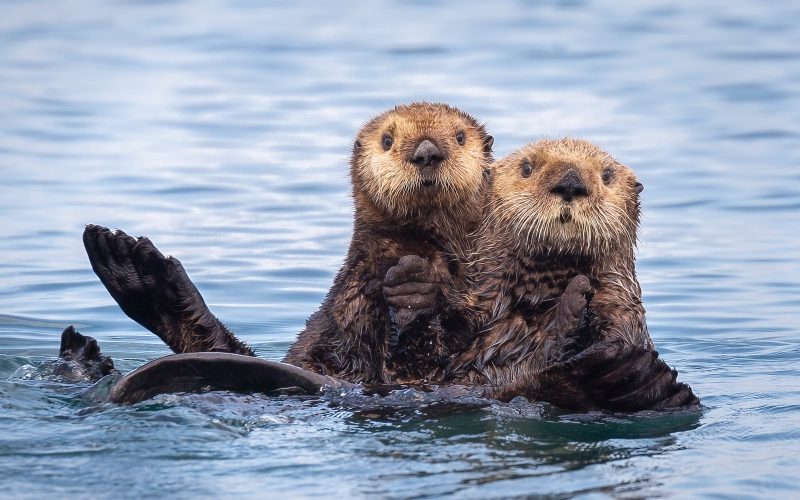Sea otters are one step closer to making a comeback after being absent from the Oregon coast for almost a century.
To spearhead the planning effort to return the charming creatures, which are regarded as a keystone species essential to repairing the state’s declining underwater kelp forests and managing invasive sea urchin populations, local tribes and charitable organizations have been awarded a $1.56 million grant.
According to Jane Bacchieri, executive director of the Elakha Alliance, a nonprofit organization devoted to reviving sea otters in Oregon, they are the protectors of the kelp forests.
Those kelp forests are far more susceptible to environmental changes, such as the rise of invasive sea urchins or ocean warming, when sea otters are absent.
In order to repopulate an 800-mile length along the coasts of Oregon and Northern California with sea otters, the alliance joined up with the Confederated Tribes of Siletz Indians, a number of other coastal tribes, and charitable organizations on the grant.
The grant will help them gain experience, finish important scientific studies, perform socioeconomic analyses, select possible locations, and get support—including from the fiercely opposed shellfish industry—as they continue their years-long efforts to reintroduce the creatures in Oregon.
Proponents anticipate that their proposal will persuade the federal government to expedite the reintroduction of sea otters, potentially bringing the animals back within ten years.
REINTRODUCTION FAILED
In the past, sea otters were common throughout the West Coast, from Alaska to Baja California.
Near Point Lobos State Park in California, a tiny raft of sea otters floats in the water.Getty Pictures
For thousands of years, they lived alongside Indigenous people, who regarded them as revered relatives and as representations of wealth and status. Sea otter robes were reserved for high-status individuals, preventing overhunting even if some people hunted them for their hides.
“To us, sea otters have stood for prosperity,” said Robert Kentta, a member of the Elakha Alliance board and a member of the Siletz Tribal Council. The tale of the girl who wed Sea Otter is one of them. Sea Otter would leave presents for her community on the beach after the marriage.
During the fur trade era, however, the creatures were hunted to extinction. Otter Rock is where the last known Oregon sea otter was shot in 1906. In California and Alaska, there were only a few remaining remnant populations.
Sea otters, the largest of the weasel family, with the densest fur of any mammal on the planet. Sea otters lack a fat layer, in contrast to the majority of other marine mammals. Rather, they must consume 25% of their body weight in food each day and rely on their thick fur to stay warm. They eat clams, mussels, crabs, and sea urchins. They can even smash hard-shelled prey with tools and rocks.
Nearly 100 sea otters were transported to Oregon from Alaska’s Aleutian Islands at the beginning of the 1970s. The remaining half were released in Cape Arago in 1971, with the other half in Port Orford in 1970 and 1971.
The reason why the reintroduction didn’t go well is still unknown.
A few of the animals hurried away. Furthermore, although few pups were recorded, the otters’ numbers drastically decreased by 1975, and ten years after their arrival, they vanished completely.
In the early 1970s, sea otters were also brought back to Southeast Alaska and the Olympic Peninsula in Washington, where they have flourished in contrast to Oregon. According to Bacchieri, there are currently roughly 2,000 sea otters in Washington and 30,000 in Southeast Alaska.
The southern sea otter, which is classified as a threatened species under California’s Endangered Species Act, has a population of several thousand individuals in Central California.
In contrast, sea otters are exclusively found in the Oregon Coast Aquarium and the Oregon Zoo in Oregon. There have been sporadic reports of wild sea otters in the state, most likely males swimming in from the Olympic Peninsula. The last one, in July, generated a lot of excitement when two sea otters, likely from Washington, were spotted swimming close to Ecola Point, just north of Cannon Beach.
On June 28, 2024, two sea otters were spotted on Cannon Beach, close to Ecola Point.Elakha Alliance | Chanel Hason
PRESS FOR THEM TO RETURN
David Hatch, a member of the Siletz tribe, discovered a collection of old kelp maps in the late 1990s and discovered that the majority of the verdant underwater forests depicted on the maps were vanished.
He discovered through research that the lack of sea otters, one of the top predators of tiny purple sea urchins, had turned numerous kelp forests into dead zones by allowing the urchins to eat kelp.
Hatch, an engineer for the city of Portland, organized a loose coalition of otter supporters under the auspices of the nonprofit organization Ecotrust to aid in the return of the mammals to the Oregon coast. The Elakha Alliance was his name for it.
The Chinook trading language’s word for sea otter is elakha.
Following Hatch’s passing in 2018, that organization changed its name to a nonprofit, which has been steadfastly pursuing his vision.
In addition to sponsoring studies with an economic and tourism focus and conducting a thorough scientific assessment and public policy analysis to ascertain the viability and effects of restoring and protecting sea otters, the coalition of tribes, nonprofit leaders, and conservation organizations has also engaged in public outreach to increase support for sea otters.
The U.S. Fish and Wildlife Service accepted the alliance’s scientific findings when Congress ordered the federal agency to examine the viability and expense of reintroducing the creatures.
Similar to the nonprofit, the Fish and Wildlife Service came to the conclusion that, from a biological, socioeconomic, and legal standpoint, sea otter reintroduction would be successful in Oregon and Northern California. Additionally, it was discovered that it would help the species and the nearshore marine ecosystem in a number of ways, such as increased biological variety, improved resistance to climate change, and the regeneration of seagrass and kelp forests.
Although its report concluded that significant widespread economic impacts from the reintroduction are unlikely and would largely depend on the sites chosen for the animals’ release, the wildlife agency acknowledged concerns regarding possible competition by sea otters with the shellfish industry. Otters eat a variety of shellfish, including sea urchins, crabs, and other shellfish.
In anticipation of the upcoming Dungeness Crab season, crab pots are stacked in the Port of Newport.For The Oregonian/Lori Tobias
The shellfish business in Oregon has strongly opposed the return of sea otters to the state.
In just the last four seasons, the Dungeness crab has contributed more than half a billion dollars to the Oregon economy, making it the most lucrative single species commercial fishery. According to Crystal Adams, executive director of the Oregon Dungeness Crab Commission, the introduction of sea otters directly threatens this important sector.
In Alaska, where sea otter populations have increased dramatically, fishermen have already blamed the otters for decreasing their catches; Adams worries that this might happen in Oregon.
“You see, otters eat a lot,” she remarked. They consume Dungeness crab, which may result in a significant decline in the number of crabs accessible for harvesting for both commercial and recreational purposes.
While eating shellfish at Elkhorn Slough in California, a sea otter floats.Gretchen Stuart Kay
However, according to the Elakha Alliance’s research, Oregon has never had more than 5,000 sea otters because the state’s and Northern California’s coastlines are rugged, vulnerable to strong storms, have a narrow and steep continental shelf, and lack the inland passages, inlets, and protected habitat areas that have sustained otter populations in Alaska.
Given that sea otters typically have one pup a year, they are unlikely to proliferate here in greater numbers for many decades, Bacchieri said.
THE GRANT
The three-year planning effort will allow tribes and their partners to contract with scientists to run population models at various coastal sites to help inform site selection. Other scientists will do ecological site assessments to verify the availability of food for the otters, check on kelp status and other conditions.
The work will also include studies such as a Fisheries Economic Impact Assessment and engagement with the fishing community to allow them to weigh in about suitable areas.
Tribes also will collect cultural and traditional ecological knowledge about sea otters and they and the Elakha Alliance will prepare a public outreach effort, in conjunction with sea otter nonprofits.
In addition to the Siletz tribe and the Elakha Alliance, other project partners include Defenders of Wildlife, the Confederated Tribes of the Coos, Lower Umpqua and Siuslaw Indians, the Yurok Tribe and the Tolowa Dee-ni Nation, the latter two based in California. The Oregon Coast Aquarium, which is building a marine mammal rehabilitation facility, and the Oregon Zoo also are on board.
A sea otter wrapped in kelp floats in Monterey Bay, California.Gretchen Kay Stuart
There are still many unknowns, including figuring out which sites are best not just for the animals, but also for the coastal and fishing communities where the donor animals would come from and how to best monitor them after their release.
Uprooting an animal like that, even under the best conditions, It s pretty traumatic, Kentta said. So getting them established is a bit of a challenge, but once they are established, then they should be able to take care of themselves as long as there s no other threats.
As of now, there s no proposal to reintroduce sea otters.
Last week, Fish and Wildlife spokesperson Jodie Delavan told The Oregonian/OregonLive that she had no other updates. The next step, according tothe agency s website, is to evaluate potential sea otter reintroduction scenarios with the help of expanded scientific modeling from the scientific community.
Still, sea otter advocates hope for a decision within the next 10 years.
This whole effort is a mission of hope, Kentta said. We ve seen decline in near shore ecosystem health and there s all sorts of side benefits to sea otter reintroduction and having healthy kelp forest habitat, not just for species, including baby salmon, but for the potential to contribute to lessening coastal erosion, increasing carbon capture and up the level of oxygen in the water.
Gosia Wozniacka covers environmental justice, climate change, the clean energy transition and other environmental issues. Reach her [email protected] 971-421-3154.
Our journalism needs your support. Subscribe today toOregonLive.com.









